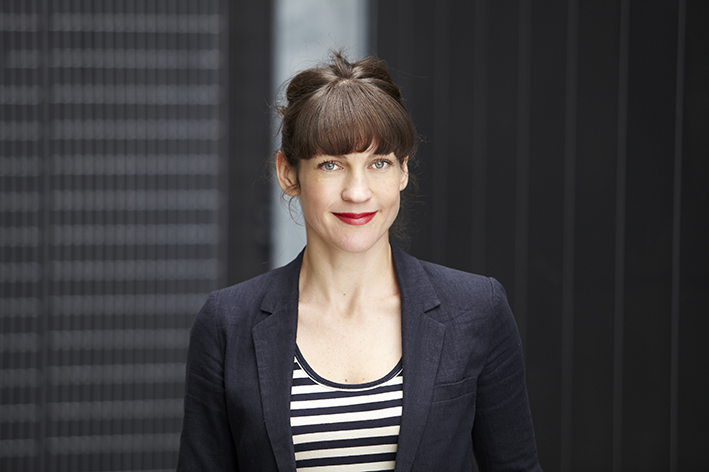In Melbourne, jewelry that could improve health or even save lives

MELBOURNE -- If you look inside Leah Heiss's cupboards, you'll find they are packed with electricity-conducting textiles, shape-memory metals, electroluminescent cables, ferro fluid (a material that responds to the presence of a magnetic field), and even a chunk of aerogel known as space insulator.
As evidenced by these tools of the trade, Heiss is no ordinary jewelry designer.
The Melburnian creates jewelry that doubles up as health devices, aimed at improving people's lives and, at best, even saving them. "The ideal is to create a technology that people might grow to love, like a favorite ring or scarf, something they really want to use -- but that incidentally will keep them alive," Heiss explains.
As a trans-disciplinary designer, Heiss collaborates with disparate fields such as art, science, technology, health and engineering to create high-tech jewelry that is both aesthetic and unobtrusive, allowing the user to wear it for a prolonged period of time without experiencing the discomfort or stigma that can be associated with wearing medical devices.
One such device is the Hearing Programer Heiss developed for the hearing aid company Blamey Saunders Hears. The device gives the hearing aid users the option to fully personalize their hearing aids and to tailor their hearing experience on-the-go, thereby cutting out the costs of, and need to, visit an audiologist.
The Programer is more than a remote control. For example, the user, can adjust the acoustic quality via a mobile device or computer to suit a quiet internal place like a library, or a noisy external environment, such as walking through a crowded festival.
Available for sale in August, the Programers will be sold as part of a Blamey Saunders Hears product pack, costing from AUD$2,255 (USD$2,117), and will include two hearing aids and remote technical and audiological support services. Prices of traditional hearing aids in Australia vary significantly, and can cost between AUD$2,000 (USD$1,878) and AUD$14,000 (USD$13,144).
According to Dr. Elaine Saunders, CEO of the Blamey Saunders Hears, about one in five people (one in three over 60) have hearing loss, but most people don't do anything about it, due to artificial barriers including, among many factors, "not wanting to look old or disabled." She estimates the cost to Australia of untreated hearing loss to be over AUD$11 (USD$10) billion.
The Hearing Programmer follows the success of the Diabetes Jewelry range, which was designed by Heiss to replace syringes and enable pain-free delivery of insulin to the body. The Diabetes Applicator Neckpiece discreetly applies a transdermal patch to the skin while the ring keeps the patches in place. So, rather than having to inject insulin with a syringe the wearer simply applies a pre-loaded patch to the inside of the finger with their neckpiece and positions the ring to keep the patch in place.
The release of the Diabetes Neckpiece has been delayed due to the shortage of R&D funding. However, the jewellery continues to be exhibited, and generate discussion regarding the potentials of jewellery as life-saving device.
According to the Australian Government, an estimated 280 Australians develop diabetes every day. It is Australia's fastest-growing chronic disease. Yet, in Australia, to get a medical device from this stage through product testing to commercialization moves slowly, taking anywhere between seven to ten years.

The practitioner explains most of her projects are in functioning prototype phase, but bringing a product to market is not her primary motivation. "I define success as helping to shift people's thinking around what they need to accept from pharmaceutical companies," Heiss explains.
"Opening up the debate around what form medical technologies must take is key to why I am involved in these projects. The potential for our personal treasures to house medical capacity means that regular people get agency and control over their health, rather than just having to accept what is served up to them," she says.
Acting as a translator between experts, Heiss's ability to look at the viewpoints of different disciplines is critical in her work in therapeutic technology, a term she explains as any "drug delivery, monitoring and diagnostic technologies that are used to improve or maintain human health."
As part of Heiss's unique approach to design, she works on site at various organizations (she refers to this practice as "embedding") in order to develop a knowledge of the project, from the inside out.
This process has enabled her to create working prototypes that would not have been possible without this collaborative approach. For instance, she has created vessels to remove arsenic from drinking water, a swallowable 'seed' which unfurls like a flower in the digestive tract to detect disease, and emergency jewelry, which features the global symbol for medic alert, to identify allergies and identity in times of medical crisis.
"I call them trans-disciplinary projects rather than inventions as they are often working with existing technologies but aiming to create more people-focused ways of using or applying these technologies," Heiss explains.
Heiss says it is the task of a designer to truly empathize with the user. "The final user might be a 64-year-old woman who is finally, through gradual hearing loss, forced to use a hearing aid. Or the 14-year-old who needs to inject insulin on a daily basis," she says.
"Medical devices are functional but rarely something we really want to wear," says Heiss, who is also a Ph.D. candidate exploring the emotional relationship that exists between people and their health technologies. "To destigmatize is to create something that people actually want to be part of their lives."
The Melburnian's inventions mirror a growing interest globally in health-related technologies, as evidenced in the investment in wearable devices such as Google Glasses, and the rumored Apple iWatch that will allow people to track their health information.
"There is greater interest in health technology that will help people be more independent, but consumers, scientists, engineers and designers are moving faster than the medical and healthcare systems," Dr. Saunders explains.
Heiss believes there is a strong role for designers to speculate on the future of medical technologies rather than be constrained by what is possible right now. "I look to a future in which design might inform the development of medical technologies, rather than design being something that is brought in at the last phase to create the housing," she says.
Currently Heiss is working with Melbourne's RMIT University and a public hospital to create a piece of jewelry to replace the cardiac holter monitor, a device that continuously records the heart's rhythms and worn by people who have recently had a heart attack. The project is in the initial concept design stage.
PHOTO: Leah Heiss with Nanotechnology Victoria, Diabetes Applicator Neckpiece, Reloader, Ring. 2007, Cast Silver with stainless steel internal mechanisms. Photo by Narelle Sheean
This post was originally published on Smartplanet.com